600 km Brevet: coasting, walking and a lot of riding
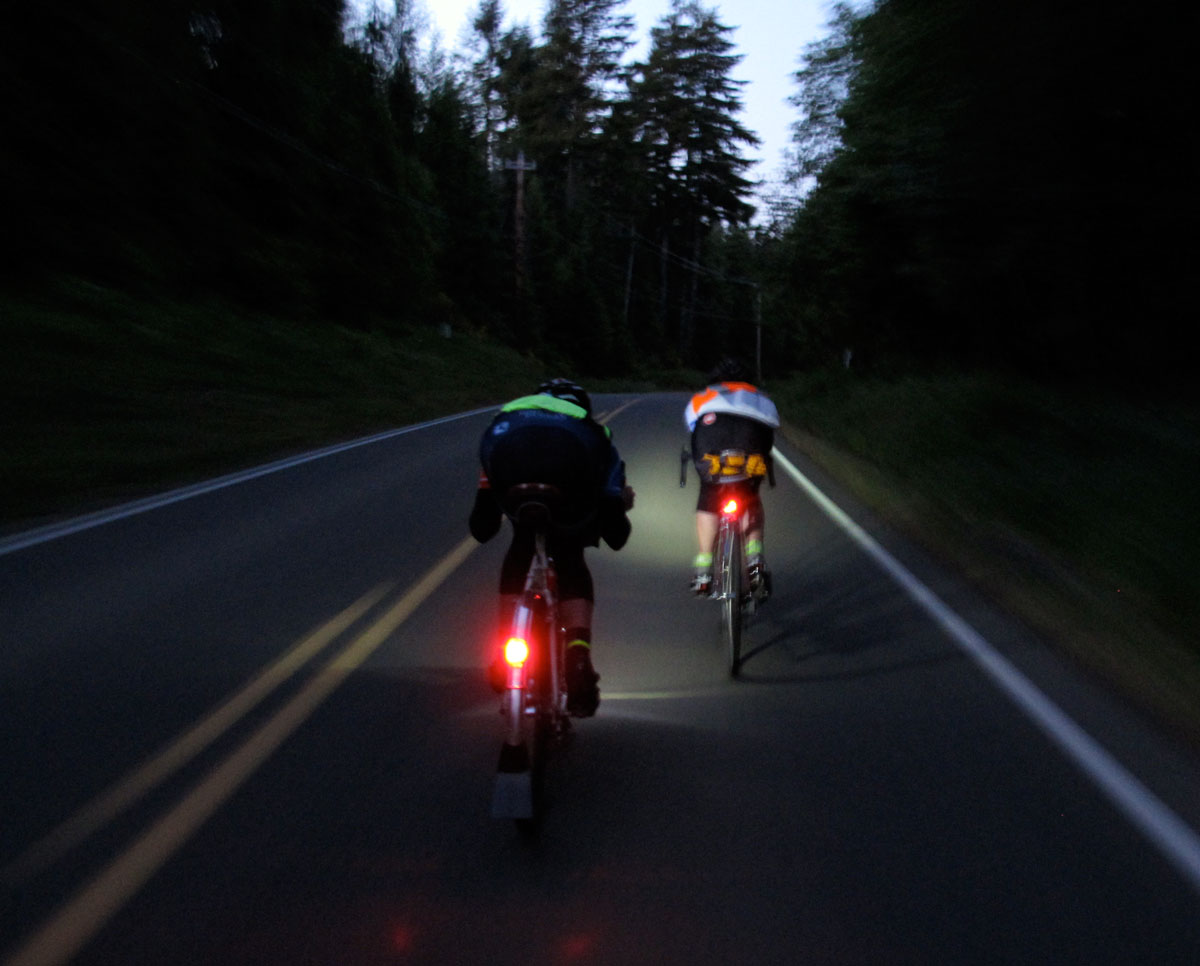
Last weekend was the Seattle International Randonneurs 600 km brevet. Not only was it the last brevet we needed to qualify for Paris-Brest-Paris, but we also had a goal of finishing it in R60 time: 24 hours for 600 km.
Some readers my be surprised by our secrets on how to post such a fast time: We coasted a lot, and we walked a lot. (Of course, we pedaled as efficiently as possible in between coasting and walking.)
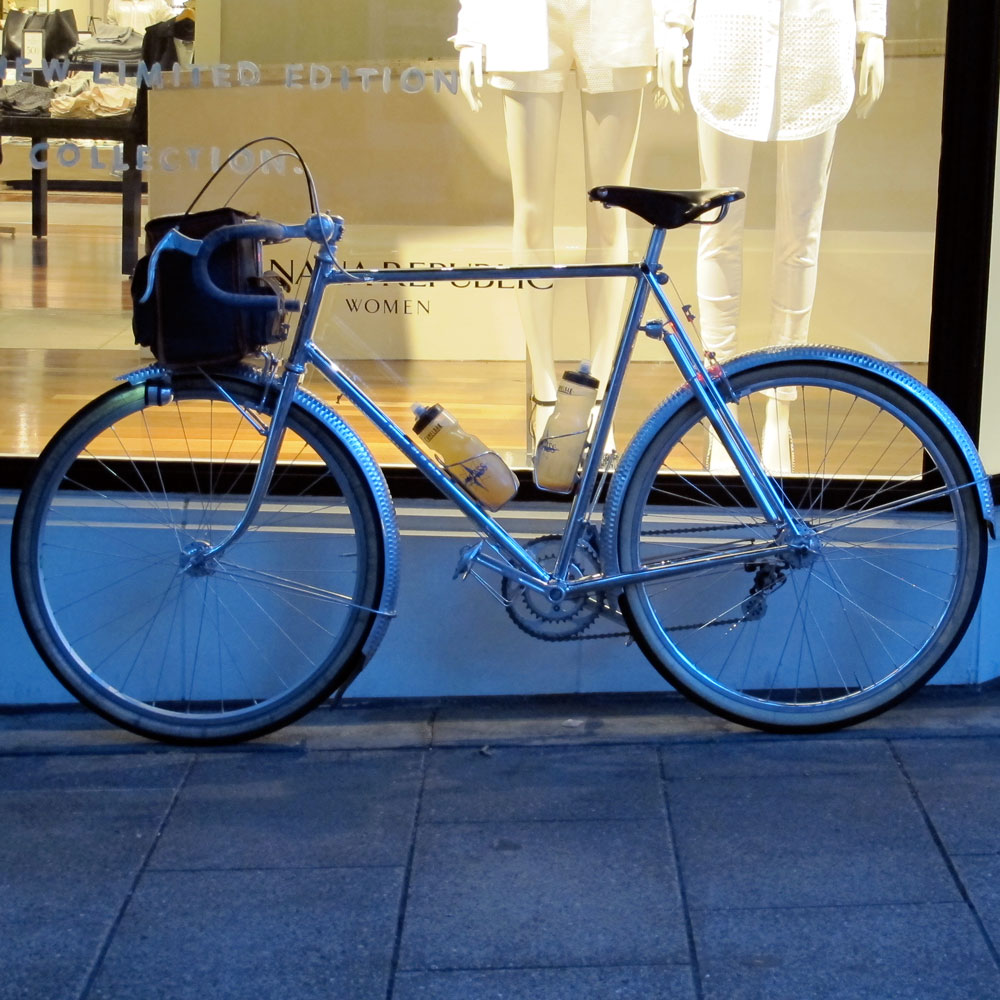
As usual, I rode my bike to the start. It was fun to ride through a deserted downtown Seattle so early on Saturday morning. It’s a moment full of anticipation, of looking forward to an extraordinary day on the bike.
The ride started at 6 a.m, and almost immediately stopped again. A long freight train was blocking a level crossing. Rather than wait (these trains can take 15 minutes or longer to get moving), some of us decided to head a few blocks to the North, where there is an overpass across the tracks.
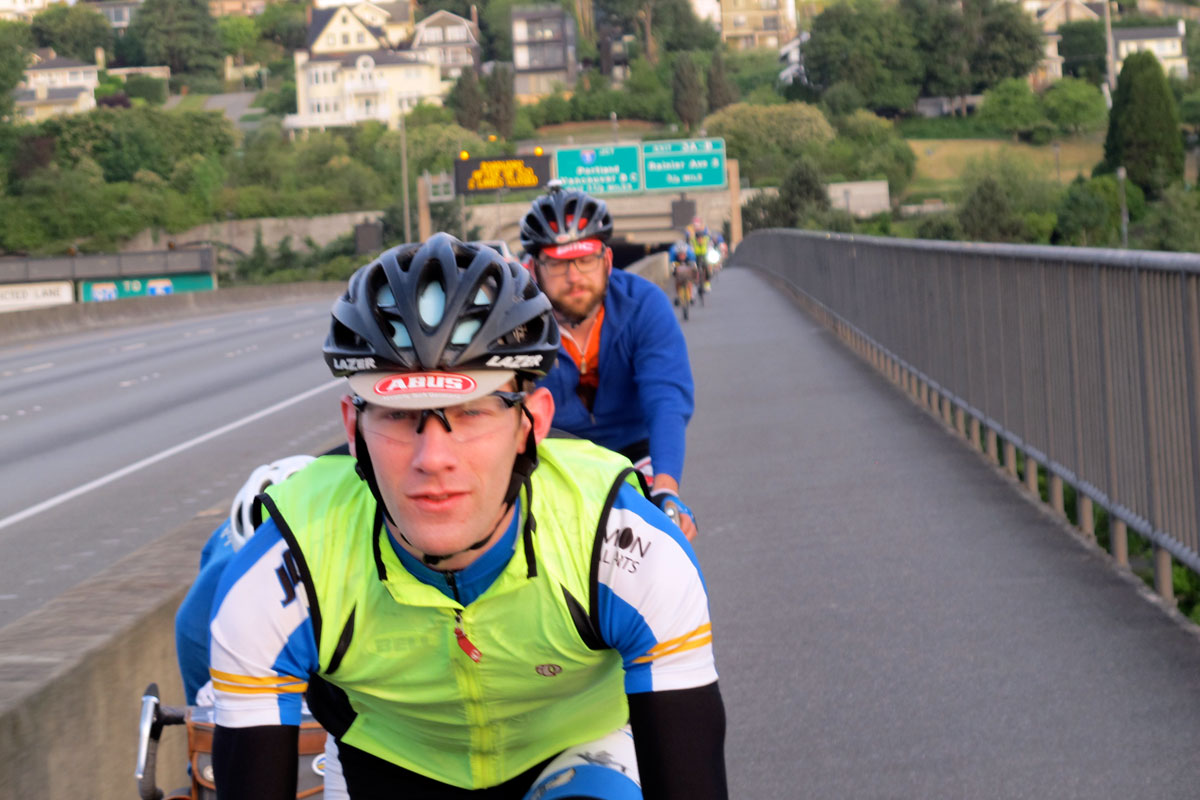
We climbed up the steep hill to leave the Duwamish River valley, rode through the tunnel on top of I-90, then coasted down onto the Lake Washington bridge. Hidden behind Wade is Theo, in the aero tuck to make the most of his slender build. It’s amazing how low and narrow you can get on a bike… In the back, Ryan is leading the second group, also in the aero tuck to maximize his speed and catch back on without wasting any energy. As you can see, the coasting started early in the ride…
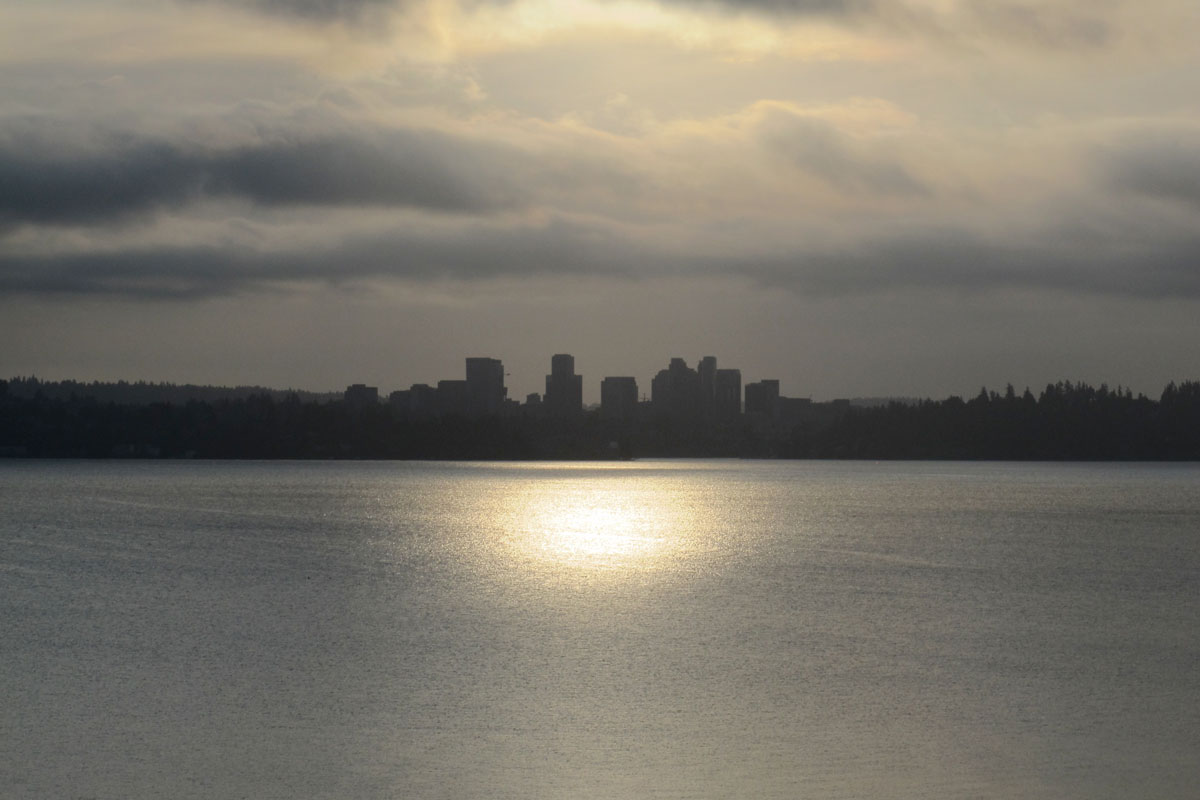
The morning was overcast, but the views were no less spectacular for it. The sun was peeking out from behind the clouds as we looked toward Bellevue. It was surprising to me how unstable my bike was as I took the photo. “Look where you want to go,” I wrote in one of Bicycle Quarterly‘s “Skill” columns. This is even more true when riding no-hands.
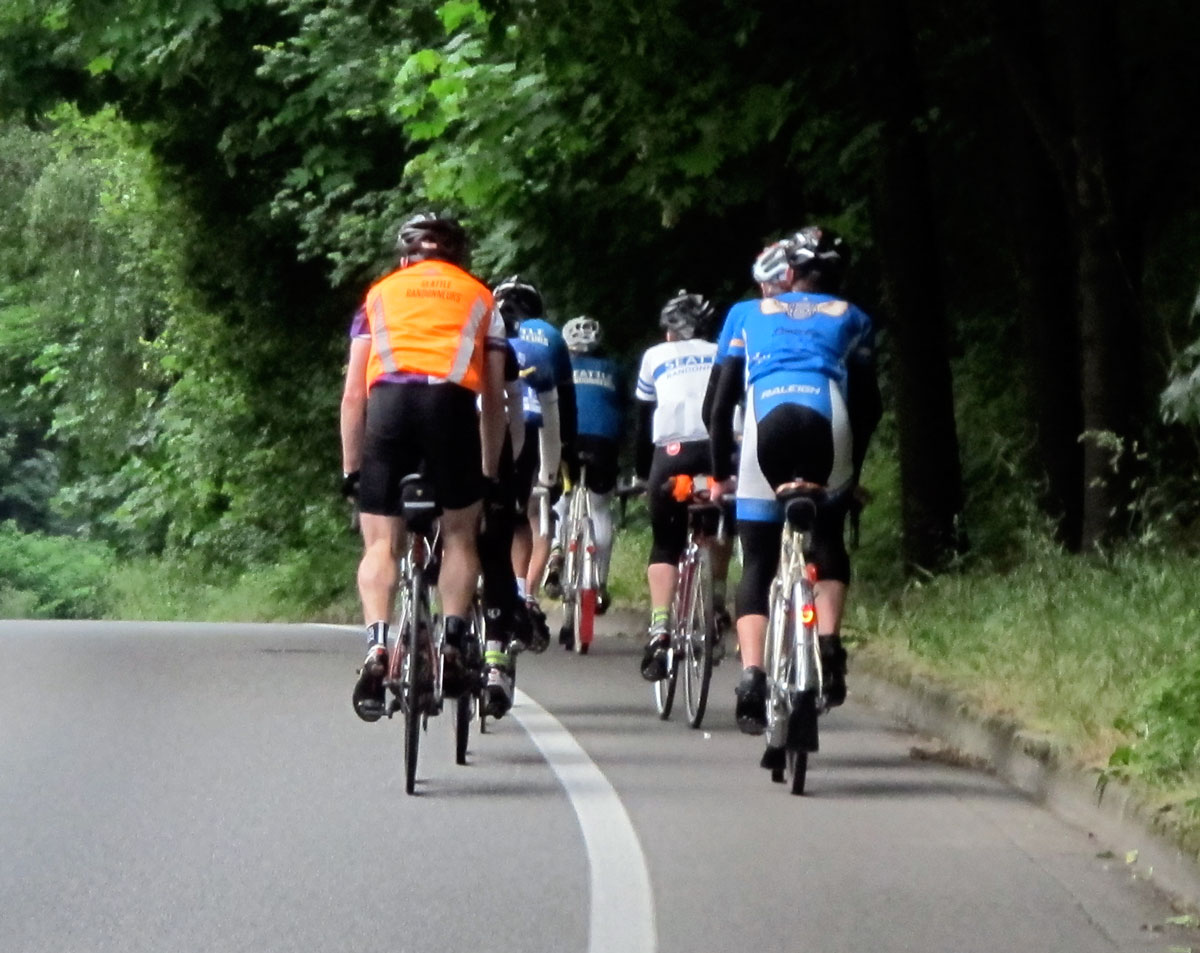
Our group smoothly climbed the Cascade foothills as we made our way south toward Mount Rainier. The reason you see so few photos of riders pedaling is simple: It’s hard to take photos while working hard. It’s only when coasting that I can easily reach into my handlebar bag and pull out the camera.
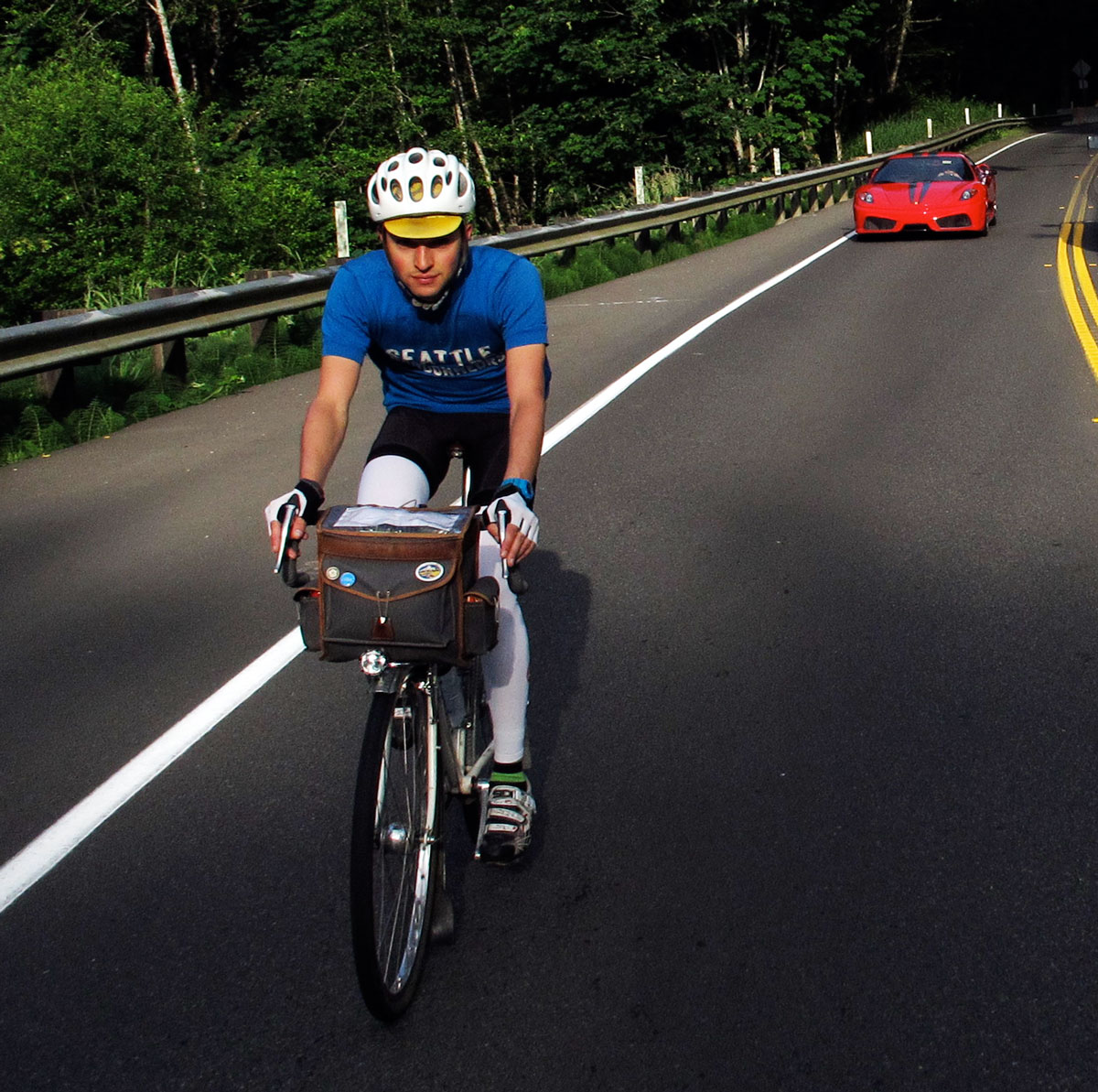
We weren’t the only ones having fun on the deserted roads this morning. It seems like we see this red Ferrari during every brevet that goes through the May Valley. Later during the day, when the going wasn’t always easy, I sometimes pined for something a bit more motorized than my mount…
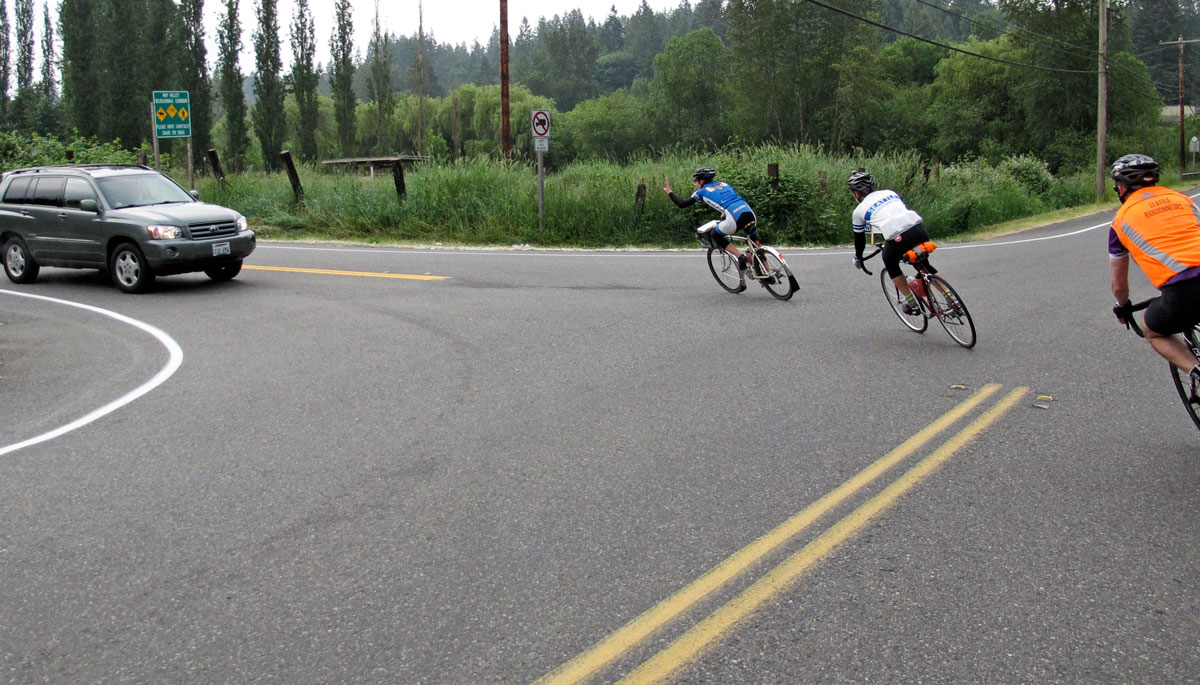
With a time goal in mind, there wasn’t much time for slowing or stopping, and corners were taken at speed. I appreciated that even in mid-corner, Wade had a quick wave for the driver who had stopped for us. (We had the right-of-way, but unfortunately, not all drivers respect that.)
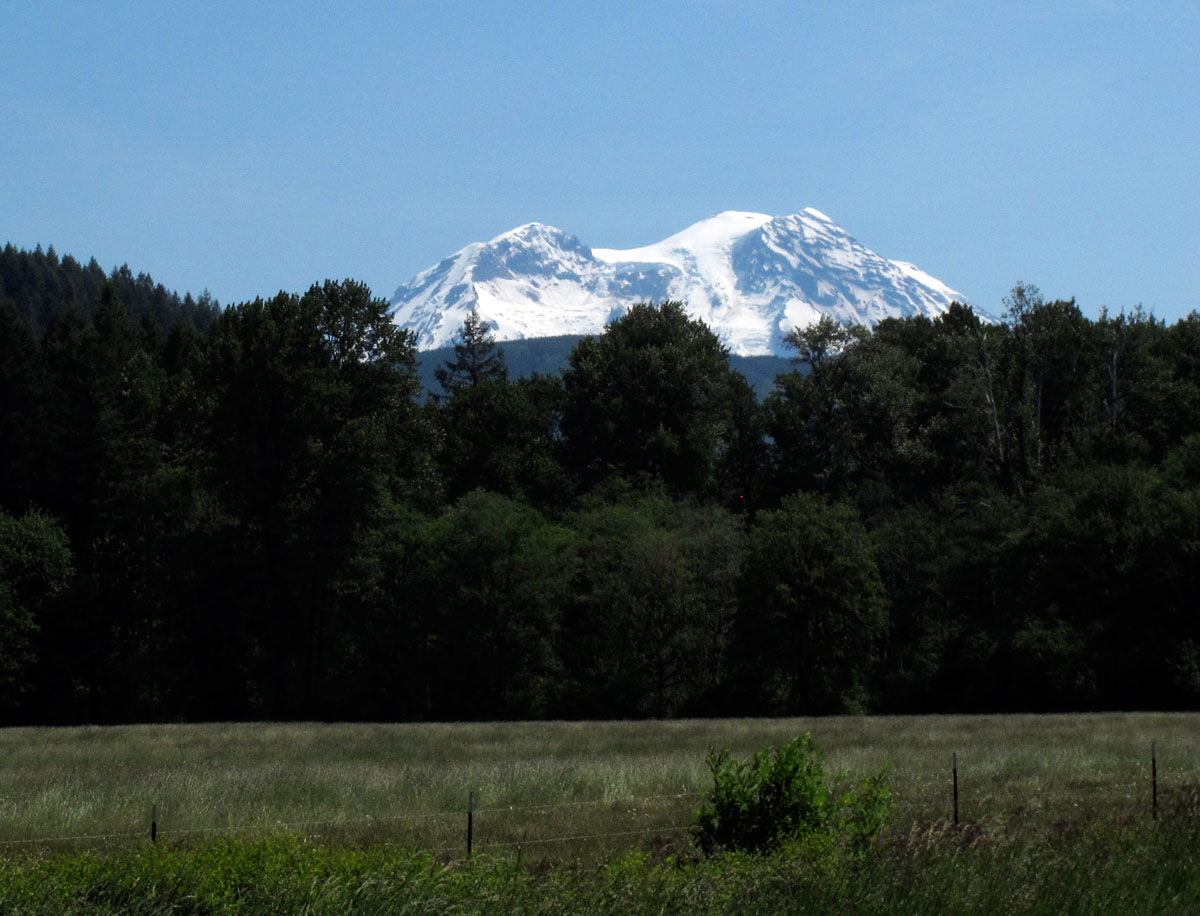
A few hours later, and we were approaching Mount Rainier. It looks so different every time I see it, depending on my viewpoint and the season. Right now, the volcanic cone still is covered with snow. It’s a long climb up the Nisqually River valley, but the gradient is almost imperceptible. So it’s easy to work too hard here trying to keep the speed up. The secret is to relax and go a little slower, rather than ride yourself into the ground.
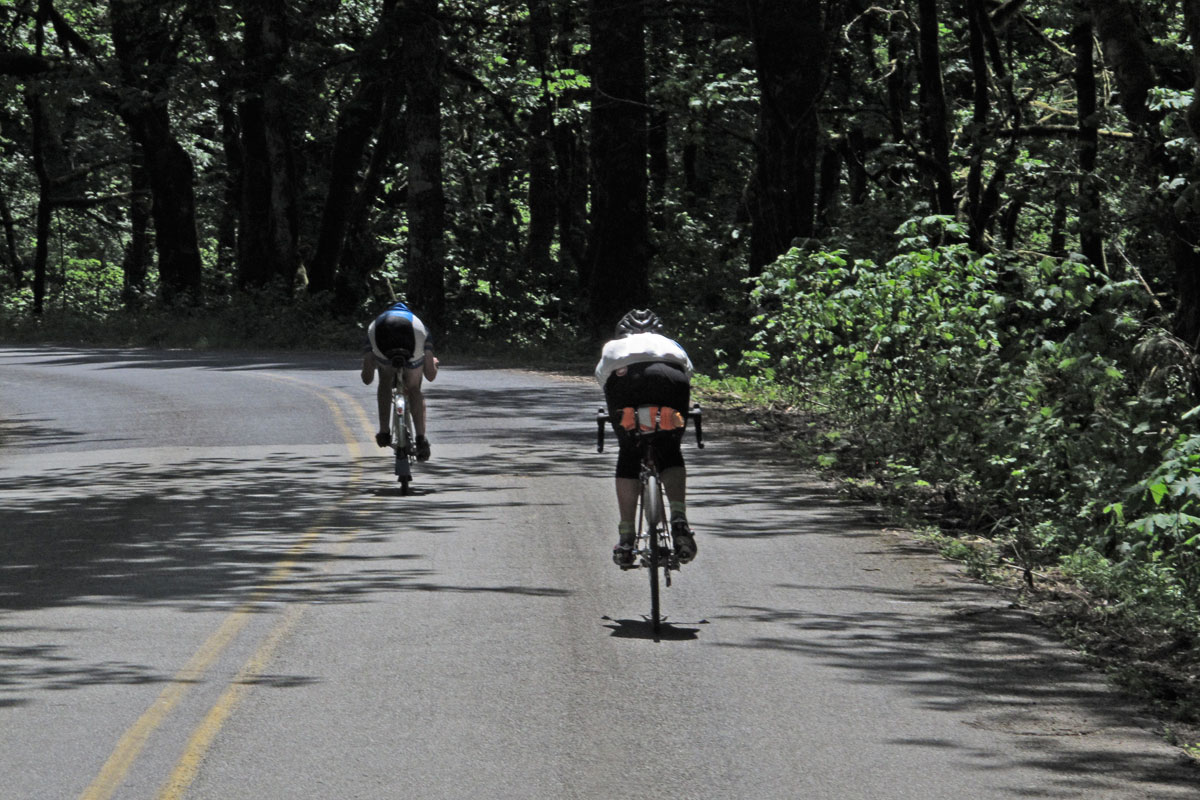
Skate Creek Road always is a favorite, and on this glorious day, it was no exception. We played during the descents, here Steve is in the aero tuck, rapidly catching up to Wade who hasn’t tucked his arms and is visibly less aerodynamic.
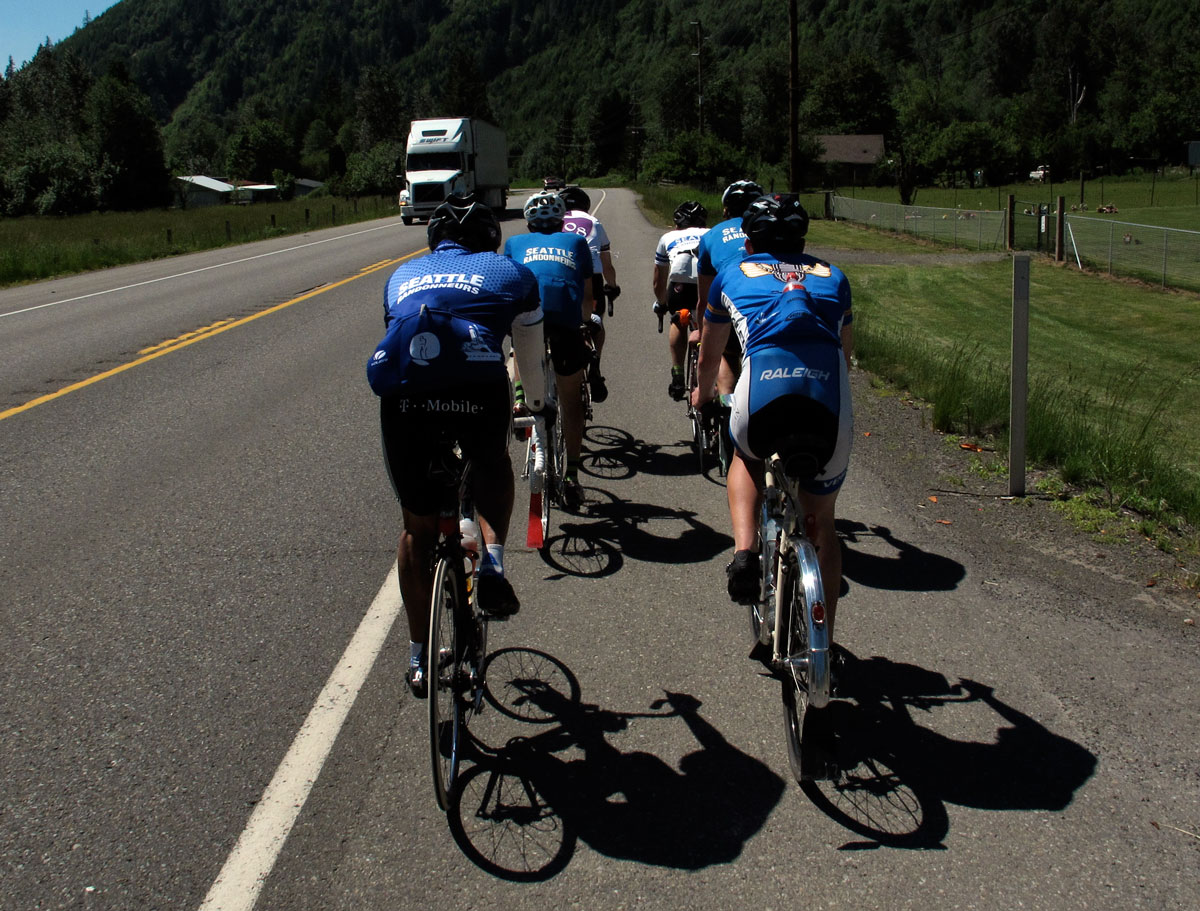
As expected, we encountered fierce headwinds in the Cowlitz River valley as the warm air from the lowland rose up the slopes of the Cascades. Fortunately, our group of 7 was large enough to form an efficient rotating paceline. The wind was slightly from the left, and you can see that only Steve (first on the right) is bent low over the handlebars. He is just getting to the front, so he’ll be facing the wind head-on. But he has momentum from drafting the rider to his left, and he is about to pull off himself and slow down. The riders on the left are facing the wind with less protection, but they are riding slower than the protected riders on the right. This means that no rider ever faces the wind for more than a few seconds.
We went about 2 mph (3.2 km/h) faster than if we had just ridden in a standard double paceline, and expended less energy. And it was fun.
We had asked the organizer for permission to use backroads that took us off the “official” course that ran along the highway. We were assured there were no secret controls on these stretches of relief from the monotony and traffic of the highway. As an added bonus, the wind was much less strong on the sides of the valley.
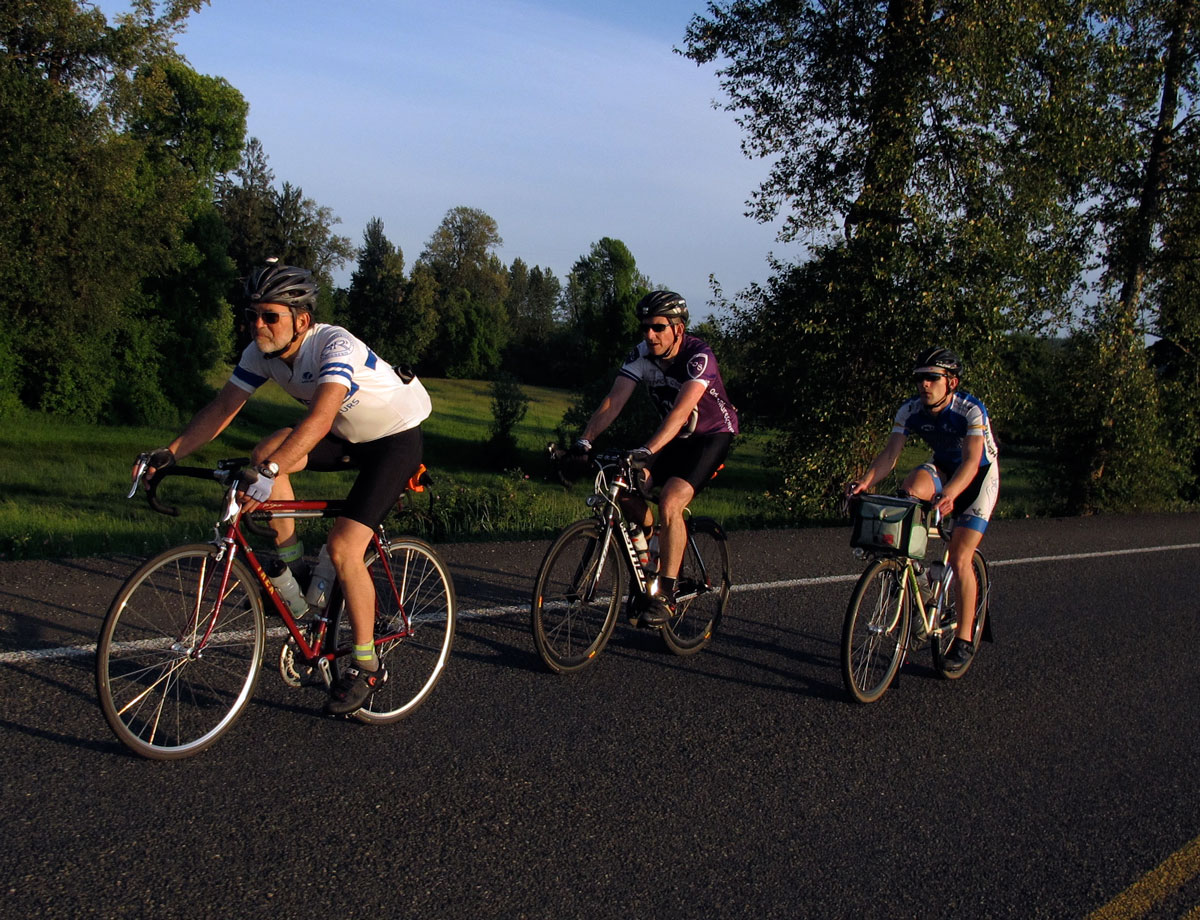
The pace started to take its toll, and several riders elected to make a longer stop in Morton, so our group now was down to four. Here we enjoy the golden evening light on the way to the “overnight” control in Elma. The rough pavement seemed to take a toll on James on his racing bike, and he decided to stop and sleep, while Steve, Wade and I continued.
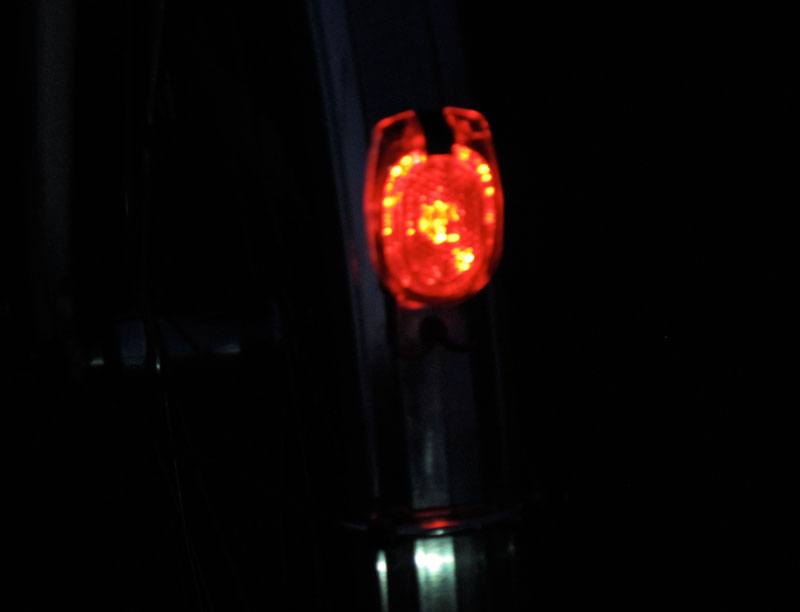
Steve, Wade and I have ridden a lot together. We know each other’s styles, so we can ride through the night without having to worry about touching wheels and crashing. Each of them is very smooth and predictable. The photo at the top of the post is typical: Coasting downhill, playing with each others’ drafts, so we are rotating even as we are in the aero tuck. Both also are great conversationalists, so the time never gets long with them!
Night fell as we rode along the Hood Canal, a glacial fjord that was most beautiful in the twilight. The hillsides were reflected in the water, and a few lights shimmered on the other side, while the sky slowly turned dark. (Unfortunately, my “on-the-bike” photos did not turn out.)
At midnight, we reached the control at the edge of the Tahuya Hills, where we enjoyed the hospitality of the volunteers, who made us hot soup. It was fun to sit around a campfire for a few minutes and relax, before tackling the pièce de résistance of this ride.
The Tahyua Hills are a magical landscape. Illuminated by the moon, the hills and valleys looked even more mystical than usual. These hills are steep and relentless, and depending on your form and state of fatigue, they can be daunting or a lot of fun. For us, it was the latter. The rises and falls of the road have a good rhythm, and we climbed them smoothly. Our headlight beams pierced the night as we speared down the descents, trying to discern where the road was leading.
When we reached the highway again with its punishing climb, we decided to walk. This allowed us to reach the long false flat on the approach to Seabeck with fresh legs. Instead of trying to recover on that long uphill, we started it with relatively fresh legs. Walking probably saved us time in the end.
We rested for three minutes in Seabeck, laying down on a picnic table. Then we headed up Anderson Hill Road. This road is the most punishing, and I don’t know anybody who enjoys it. The first part is steep. Then follows a super-fast downhill and an even steeper uphill. On top of that comes an even steeper hill. We walked the first hill, then coasted the downhill to gain speed that carried us up the next hill, before walking the third.
From there, it was relatively smooth sailing. Knowing that the finish was close made us forget the little aches and pains that are an inevitable part of such a long ride. Twilight announced the new day as we approached Port Gamble, and more backroads took us back to Bainbridge Island and the finish. We completed the ride in 23:35 hours and now are on our way to PBP! It was a hard ride, I cannot deny that, but the teamwork with friends is memorable and makes it special.


